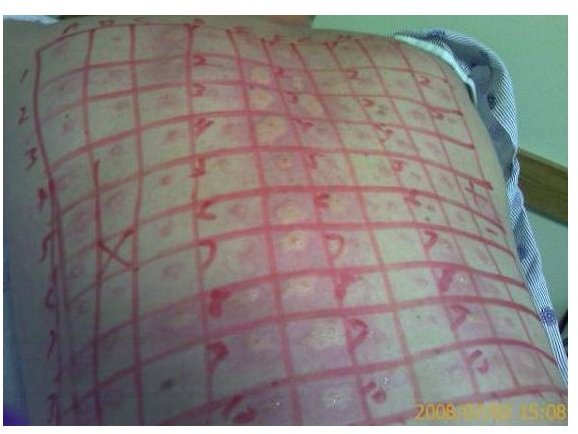Types of Food Allergy Testing
When a food allergy is suspected, clinical food allergy testing is necessary to confirm the allergy. 20% or more of adults believe they have a food allergy, but most of these are not true food allergies (Bassett, 2003). A variety of methods of food allergy testing are available to confirm a diagnosis of a specific food allergy.
Allergy Skin Tests
Two kinds of allergy skin tests are available, but only one is used in food allergy testing. This test,
the percutaneous test, is commonly known as the scratch test or skin prick test. In this test, small amounts of purified allergens are placed on the skin, usually on the arm or back, and the skin is lightly scratched or pricked at these sites. A negative control (saline) and positive control (histamine) are used to compare results. The doctor looks for a wheal and flare response, consisting of a red, raised, possibly itchy bump at the scratch site. Patients rarely suffer a serious reaction to skin allergy testing.
The percutaneous test is highly specific to different antigens, but there is no standard for determining how much of a reaction constitutes a true allergic response. The other type of allergy skin test, the intradermal test, is more definitive but is not specific enough for food allergy testing. (Li 2002)
Photo information: A patient’s back after an allergy scratch test. Some spots are visibly inflamed (wheal-and-flare response), indicating a positive result for those allergens. Photo by Skoch3, Wikimedia Commons (https://commons.wikimedia.org/wiki/File:Skintest2.jpg). License: Creative Commons Attribution ShareAlike 3.0.
Allergy Blood Tests
Blood tests for food allergies indicate whether allergy antibodies, called IgE, are present in the blood for a specific food. This type of test is called a RadioAllergoSorbent test (RAST). A specific brand of RAST test called the CAP-RAST or Immunocap measures the amount of IgE present in the blood, not just whether or not it is present. These results are usually combined with the results of skin tests.
The results of a RAST test can tell how likely it is that a food will cause an allergic reaction, but do not provide information about the potential severity of a reaction. (KFA 2007)
Food Challenge Tests
In a food challenge test, a patient eats a suspect food to see if a reaction occurs. The most useful form of food challenge test is double-blind and placebo controlled, meaning that suspect foods as well as placebos are put into capsules, with neither the doctor nor the patient knowing which capsule contains the suspect food. In a controlled clinical setting, the patient consumes the capsules and is monitored for a reaction. This test is time-consuming and presents a real danger of anaphylaxis (it cannot be used in patients with a history of severe reactions), and it is impractical to test for a variety of food allergies. It is sometimes used to see if a patient has become tolerant of an allergen (“outgrown” the allergy) or to prove that symptoms are not caused by food allergy or intolerance. Food challenges are often the only way to test for food intolerance not caused by a true allergy. (NIAID 2006)
References
- Basset, C.W., 2003. “Food allergies and reactions.” Allergy and Asthma Advocate (publication of the American Academy of Allergy, Asthma & Immunology).
- National Institute of Allergy and Infectious Diseases (NIAID), 2006. “Report of the NIH Expert Panel on Food Allergy Research.” United States National Institutes of Health.
- Kids With Food Allergies (KFA) website, 2007. “What is a RAST test? What is a CAP-RAST test?”
- Li, J. T., 2002. “Allergy testing.” Am. Fam. Physic. 66(4):621-4.
